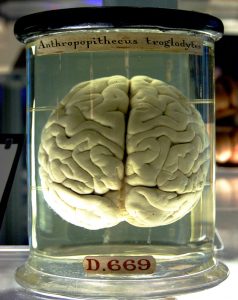
- This event has passed.
A New CPU
19/05/2016 @ 7:30 pm - 11:00 pm
Daryl wants to make his very own CPU…

Anthropopithecus troglodytes
Decoded from the bubbles of his last beer, this YACPU[*] is to be:
- His own empirical design;
- Something that is ‘different’;
- “Just for fun”!
Can the parallel accumulated might of NLUG guide him on his search?…
All at our usual Organ Grinder venue, usual 7:30pm start, details as below.
All welcome! 🙂
*:
- YACPU – Yet-Another-CPU
- CPU – Central Processing Unit
SPOILERS! (Not for Daryl’s eyes…)

🙂
Some of the further details are… 😉
(Has anyone mentioned this talk to Daryl yet?!… 😮 )
As is often the case, our combined array of loosely coupled neuronal nodes may well be awash with a combinatorial explosion of possibilities as well as enjoying good beer for added creativity…
A few ideas may well be gleaned from:
- John Graham-Cumming TED talk YouTube: The greatest machine that never was – Building today to the designs of Babbage. The race is on!
- Earlier details are given on: “The 100-year leap – Charles Babbage’s Analytical Engine was a century before its time. So why not build it now?”
Pre-dating that with some earlier examples:
- xkcd: A Bunch of Rocks
- Stonehenge was more than a temple, it was an astronomical calculator: Archaeoastronomy at Stonehenge
- Banging together 19 million cubic metres of modern-day rocks: Youtube – 32 Bit Calculator in Minecraft
For a few ‘alternative’ ideas:
- In 1936 Soviet scientist Lukyanov built an analog water computer
- MONIAC – The 70-Year-Old Computer That Runs on Water
- Rolling along some more: YouTube – Giant Digi-Comp II
Mention must be made of two other-worldly designs that closely follow some of the developments made here on Earth:
- Discworld Monthly: Hex
- lspace – Hex
- Discworld Hex Structure and technology
- Discworld Glooper “the Thing in the Cellar”
Combining some of the aspects listed so far we get this amazing amalgamation:
- YouTube: Wintergatan – Marble Machine (C64 SID Chip Cover)
- … which follows on from YouTube: Wintergatan – Marble Machine (music instrument using 2000 marbles)
Going a little more ‘home/research-brew’ recent, there are these examples:
- YouTube: Relay-Based Floating Point Square Root Calculator
- YouTube: [Electromechanical] The Numbotron – finding prime numbers
- YouTube: Analog computer game on a modular synthesizer
- YouTube: Solving Mazes With Analog Computers
- YouTube: Living Computer Created With Slime Mold?
- YouTube: … advantages of [optical] analog computing system[s]
Due to the “on-off” electrical operation of the commonly used transistor, our present day computers predominantly use binary codes. This may well move to a quaternary system if devices using qubits are successfully developed further for quantum computing. And then there is a possible advantage to using a ternary counting system:
For a fabulous glimpse of what is involved for two early CPU designs and for reverse engineering them, see:
For stark comparison, this is the sort of thing to be found in present day ‘General Purpose’ GPUs:
And here’s an ongoing connected group of ‘FLOSS‘ projects:
- RISC-V: The Free and Open RISC Instruction Set Architecture – RISC-V (pronounced “risk-five”) is a new instruction set architecture (ISA) that was originally designed to support computer architecture research and education and is now set to become a standard open architecture…
- Welcome to the lowRISC project! Creating a fully open-sourced, Linux-capable, RISC-V-based SoC, that can be used either directly or as the basis for a custom design.
- Kestrel Computer Project – Aiming to build a full-stack, open source, and open hardware home computer.

Phew!
For something a little less heavyweight and for a more ‘rapid development‘… Could the FPGA on the Parallella be subverted to create an alternative “coprocessor”?…
See what develops on the night!!…
All welcome, whether Cray-supercomputer-designer or lego-builder or philosophical spectator…
See ya there 🙂
2 comments to A New CPU
Leave a Reply
You must be logged in to post a comment.

For a giggle and a whole new way of home computing?…
Sorry, folks, just couldn’t resist this gem of a dramatic example to compare how a CPU draws an image compared to how a GPU can draw the same image:
YouTube: Mythbusters Demo GPU versus CPU
All in the eyes of the viewer and the programmer?! 😛
And for a rather interesting re-morphing of the “home computer” platform, see:
MIST – One Chip to Rule them All
All for further discussion on the night 🙂
Cheers,
Martin
For those of you fond of that Steampunk element of retro-computing:
Whereas Babbage used gearing, cams, and levers to implement decimal numerical series calculations for mathematical functions, here is a beautiful construction ingeniously using analog weighted summation utilizing springs and levers to graph Fourier analysis plots:
YouTube: Synthesis – A machine that uses gears, springs and levers to add sines and cosines
A great work of mathematical engineering computer art!
All for discussion tonight 🙂
Cheers,
Martin